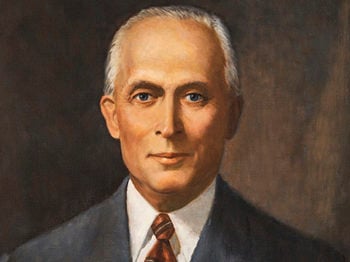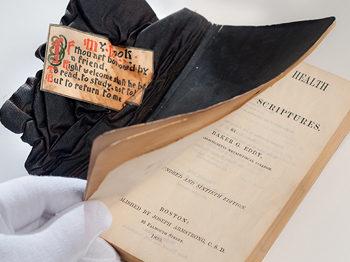“And of these stones, or tyrants’ thrones,
God able is
To raise up seed — in thought and deed —
To faithful His.”
– Mary Baker Eddy
On the evening of April 18, 1906, it might have seemed as though the rapid growth of the Christian Science movement in San Francisco, California, had been buried in the ashes and fallen stones of the great disaster.
Not so.
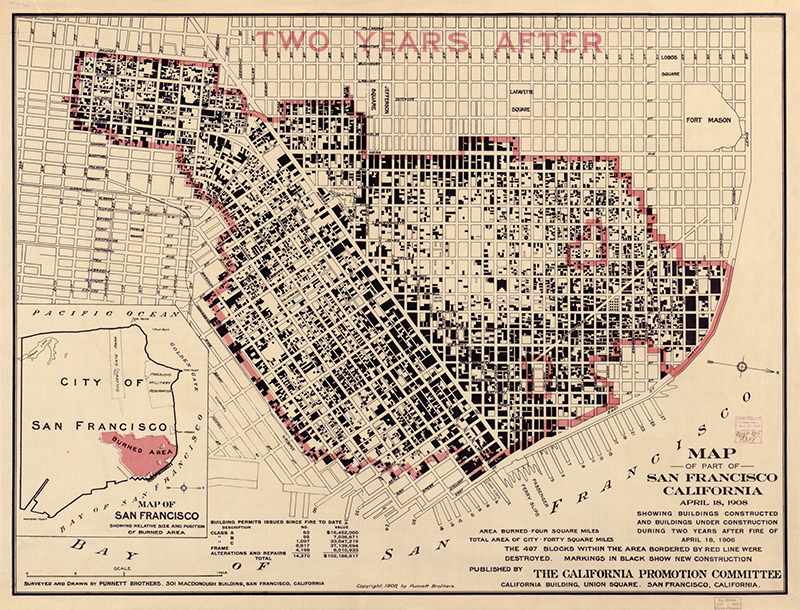
This historic street map shows San Francisco in 1908, just two years after the earthquake and fire. Each black spot represents one of the astonishing number of new buildings within the fire zone, erected or under construction since 1906. Had the map extended a few city blocks beyond the zone, it would likely also have shown the temporary meeting place of First Church of Christ, Scientist, San Francisco, which had been erected just five months after the smoke cleared. In this undertaking, the church was joining in the remarkable city-wide rush to rebuild, their efforts aided by a nationwide flood of generosity.
In the weeks following the disaster, earthquake relief committees formed in communities across the country. In Concord, New Hampshire, the Mayor convened a meeting of city leaders to collect contributions.
At first it seemed that modest donations were all that could be expected, with an ultimate goal of collecting about two thousand dollars, until a letter from one of the city’s most illustrious residents was read aloud:
Dear Sir,
Enclosed herewith is check for one thousand dollars, my contribution to the local fund for the relief of the San Francisco sufferers.
Very truly,
Mary Baker Eddy
With that to spur their efforts on, the goal more than doubled to $5,000.1
Mrs. Eddy was generous in times of public need. But she had a special interest in the San Francisco crisis. In the middle of the fire zone had been one of her students who was close to her heart — a woman who had brought Christian Science to the West Coast of the United States and, at Mrs. Eddy’s direction, moved from her hometown to San Francisco to practice and teach in a broader field.
The story had begun in 1884 — the year Mrs. Eddy went West.
Christian Science comes to California
In May 1884, seeking to bring correct teaching to a wider world, Mary Baker Eddy set out from Boston to teach a class in Chicago. In the busy three weeks that followed, she taught a class of twenty-five and lectured to some four hundred. But she returned to Boston still looking for a way to reach out further west.2
Meanwhile, a young woman from Illinois, then living in California, was about to play a pivotal role in realizing that hope. Sue Ella Bradshaw had moved to San Jose with her mother and stepfather. She was just twenty-two. She loved the idea of healing the sick, but she was abandoning any thought of becoming a physician. The thought of surgery was off-putting to her, as was medication. Beyond that, however, was what seemed an overwhelming obstacle: she herself was not well, and never had been. In fact, the family had moved to the West Coast partly in hopes that the climate would improve her failing health.
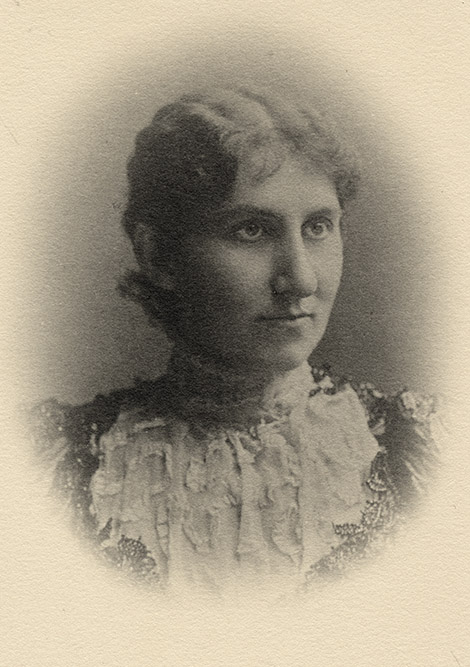
In 1884, as Mrs. Eddy was heading west to Chicago, Sue Ella was heading east to relatives in Pennsylvania. In Philadelphia, a family member told her how Christian Science had healed his wife. He urged Sue Ella to look into the religion for her own cure. Liking what she heard, Sue Ella got a copy of Science and Health with Key to the Scriptures, Mary Baker Eddy’s cornerstone work on Christian Science. She sat down and read it from cover to cover three times — in two weeks! — and found herself well.
Heading home in September, Miss Bradshaw stopped in Chicago to receive instruction in Christian Science from Caroline Noyes, who had just attended Mrs. Eddy’s class there. Afterwards, brimming with enthusiasm, young Sue Ella boarded the train to California.
Arriving in San Jose, her first patient was her stepfather, who was suffering from cancer. He was promptly healed. His granddaughter, who was blind in one eye, also received treatment. In a short time the child could see with both eyes.3 Two healings. Soon there would be more.
Christian Science had come to California — in the person of one lone young woman.
One person’s practice
Over the next three years, Sue Ella traveled three times to Boston for Primary, Normal, and Obstetrics classes with Mrs. Eddy. Back in San Jose, she began teaching and lecturing, and hers was the first Christian Science Institute on the West Coast to advertise in The Christian Science Journal. In 1887, Mrs. Eddy urged her to move to San Francisco to practice and teach a wider field. Sue Ella went where her teacher pointed the way.
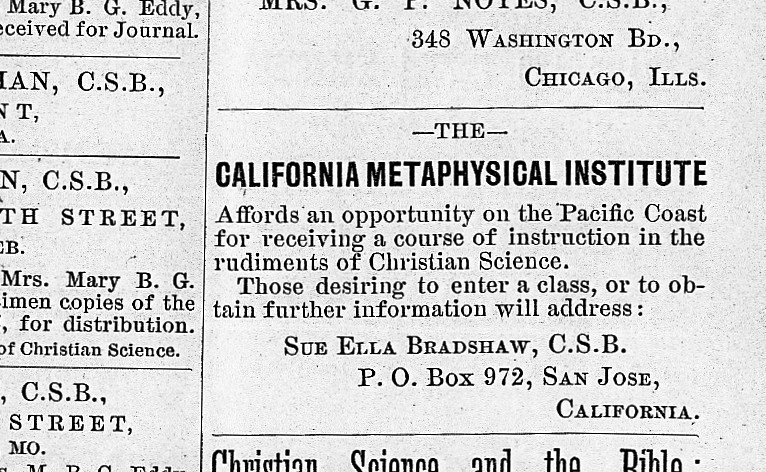
In her practice, Sue Ella’s tireless work was well known to her students, one of whom recalls, “I have known her to be out night after night, long after midnight, answering the call of someone in need — but never speaking of it.”4
A single case serves to illustrate a long trail of healings. One night Miss Bradshaw was called to the bedside of eight-year-old Agnes Tillman, who was suffering from what was then called gastric fever. Plagued with this illness since infancy, the child was allowed to eat only a special diet. But the attacks had increased in violence. Noted physicians had failed to relieve her, and on this night, predicted she would not live until daylight. Earlier that day, her father had learned of the Christian Science lady who cured by prayer, and as his little Aggie lay in a fever, he drove his carriage through a pouring rain to Miss Bradshaw’s door. Sue Ella threw on her coat, climbed in beside him, and they drove off. Entering the sickroom, she asked the parents to step outside. They protested, but she was firm. Through a crack in the door, they watched her sit by the girl’s bed for a while, her eyes closed in prayer. At last, she came out and assured them their daughter was all right, and sleeping soundly. She asked to be taken home.
The parents were aghast.
“Don’t leave us alone,” they pleaded. Sue Ella insisted calmly that God was there with them and their child was all right.
“But tomorrow, what should I feed her?” Agnes’s mother asked. “Whatever she wants,” Sue Ella replied. And she went home.
The next morning, the little girl woke completely healed and gulped down a healthy breakfast for the first time in years. The attacks never returned. Some years later found her married and the mother of five children.5
As healings like these multiplied, so did the number of people wanting to learn more about Christian Science. Miss Bradshaw taught, treated patients, and began holding church services in her home on Powell Street. Before long, the congregation filled the large first floor and overflowed up the staircase.
Overflowing
In fact, “overflow” became a theme for the coming years. In October 1895, Sue Ella Bradshaw called a small group together to organize First Church of Christ, Scientist, San Francisco. The fledgling congregation proceeded to hold services downtown in the modest-size Beethoven Hall on Post Street near Market. Within two years, that hall was overflowing, so the church moved its services to the larger Steinway Hall at Sutter and Kearney Streets. Within a short time, they had to hold overflow meetings there as well.
The membership voted to build a church of their own and bought a lot at Sacramento and Scott Streets. The congregation kept growing. In 1905, as a temporary measure while their church was being built, they leased the gothic-style former Sherith Israel synagogue at Post and Taylor Streets. Soon they had to hold overflow services in the vestry.6
On their lot at Sacramento and Scott, foundation stones had been laid and piles of lumber awaited construction, as congregants flooded into their temporary synagogue/church on Easter Sunday 1906.
It was to be the last service held there.
Three days later, in the early morning hours of Wednesday, April 18, 1906, the temblor struck. San Francisco’s earthquake and the city-wide firestorm that followed reduced the city’s business district and many residential neighborhoods to rubble. Most of the buildings left standing had no gas, electricity, or running water. The former synagogue where First Church had been holding services burned to the ground. The Reading Room, too, in the Adams Building on Kearney Street, burned, along with all its contents. Meanwhile, the congregation’s church-to-be was little more than a hole in the ground. In the wake of the disaster, half their members joined the exodus of refugees heading elsewhere.
“… neither shall the flame kindle upon thee.”
But in the midst of the debris, the determination to continue spreading the word of Christian Science remained. So did Mrs. Eddy’s student who had begun it all.
Within the burned-out fire zone, one particular house stood untouched — its water supply still flowing. It was Sue Ella Bradshaw’s home. Many of her students and their friends, stranded and homeless, flocked to her doorstep, seeking both a refuge and a beacon of hope. In the weeks that followed, the Bradshaw home supplied water and other needs to destitute neighbors and friends who came to the door. Sue Ella “lovingly took them in and gave them words of comfort, reassurance, and courage in her calm, sweet way.”7
The church Miss Bradshaw had helped establish felt called upon to continue holding services. Within ten days, their building lot was cleared. The stored lumber was used to lay a floor over the foundation and erect a covered platform for the readers’ desks. A borrowed parlor organ would accompany the hymns. On the morning of April 29, seated outdoors on makeshift benches, planks, and piles of lumber, a congregation of eight hundred gathered for the regular Sunday service. On Wednesday evenings, they met by the light of lanterns. There, for the next few months, they continued to come together with, as one member observed, “for a roof, the sunny skies or glistening stars.”8
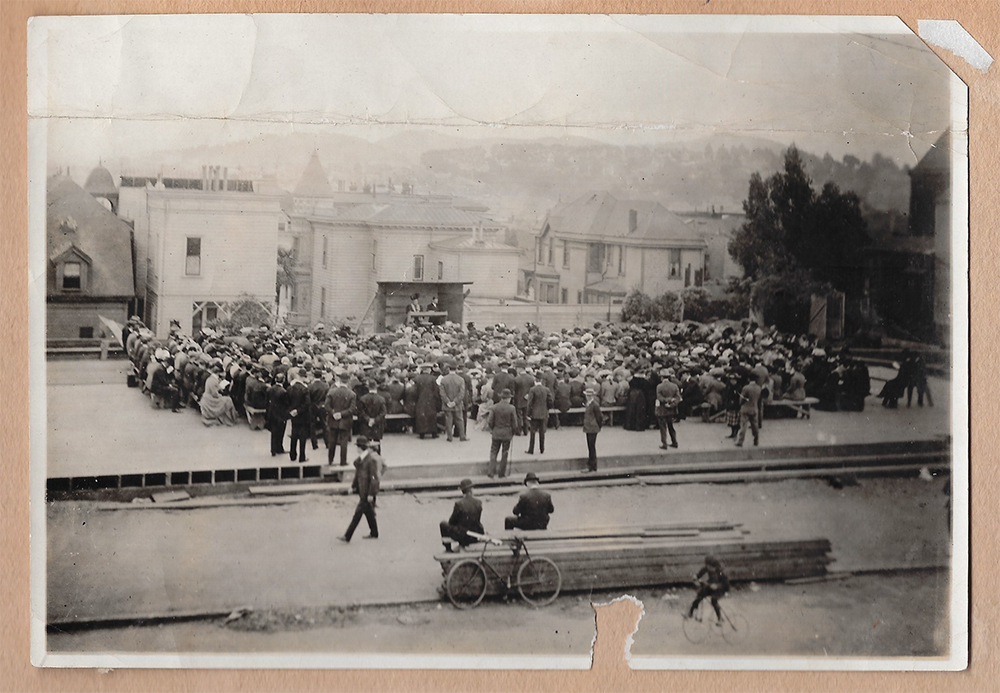
As the services continued, the walls and roof of a temporary auditorium rose around them, complete with Sunday School and Reading Room. In September, Christian Science Hall opened its doors with an air of expectancy — and seating for 1,800. A year later, they could report holding two public lectures.9 The Reading Room had sold nearly 1,000 copies of Science and Health.10 And despite losing half their membership, the hall was beginning to fill again. Plans for expanding to a larger, permanent home went forward.11
Not one had been injured…
Immediately following the earthquake, there were testimonies of protection and restoration. A young man, new to Christian Science, was buried in the collapse of a hotel, his body crammed beneath debris, his nose and mouth almost stopped up with powdered mortar. Resorting to what he had just learned of Christian Science, he reassured himself that “the mortal concept of himself was not the real self at all, that the real self was ever free, and was so right then.” When he was dug out unharmed, a doctor at the scene said he could not understand how any “living soul could have been rescued from such a place.”12
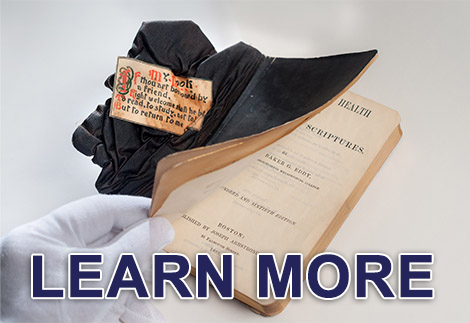
Another young man, also new to Christian Science but struggling to make a living, had just opened a stenographic business that by his account “was totally destroyed by fire and dynamite.” But, he said, this opened his eyes to “the nothingness and self-destructiveness of matter … and absolute trust in the Father. I now felt that because to sense all was lost, all was really gained through my new spiritual attitude; and it was so.” Despite the city’s commercial center lying in ruins, his fortunes rebounded. He was able to open a new, even better-equipped office than he’d had before and found his business, as he reported, “increasing daily.”13
First Church of Christ, Scientist, in nearby San Jose, had just erected a church edifice. After the quake, much of downtown San Jose was destroyed, and no church services were permitted within the city limits. And so, that very Wednesday evening, the congregation met by candlelight in a schoolhouse on the outskirts of the city where, according to the clerk’s report, they learned “our new church was practically untouched” and “none of the Christian Scientists in this community had received any bodily injury.”14
In San Francisco, too, according to all reports, not one Christian Scientist had been injured. Although there was loss of property, human needs for housing, food, clothing, and jobs were promptly being met.
San Francisco church rises
Even while meeting in the open air, the thoughts of San Francisco Christian Scientists turned again to church building and their relation as a branch to the greater vine of The Mother Church, The First Church of Christ, Scientist, in Boston. In June, a group from the city headed east. One of their party wrote directly to Mrs. Eddy:
Beloved Teacher and Leader
… Notwithstanding the material losses there has been much spiritual gain in a clearer realization of the ever-present good and greater desire for spiritual understanding. I am with a party of nine who are on the way to Boston to participate in the Communion and dedication of the Extension of The Mother Church edifice….
With love and gratitude, your student,
Frank W. Gale15
Although the San Francisco membership had been cut in half as people moved away, by 1908 their temporary hall was again overflowing. Accordingly, some of the members left to form Second Church of Christ, Scientist, holding services in the Mission District. Shortly thereafter, another group parted company to form Third Church, meeting in the Park District. Each time people left, their places were filled by newcomers, and the congregation grew.
The very next year, in 1909, First Church purchased a new lot for a permanent church edifice at the corner of Franklin and California Streets, on a site that overlooked the nearly rebuilt city. The building committee was led by its chairman, Sue Ella Bradshaw. On Saturday May 6, 1911, a small group gathered quietly in the early morning light to lay the cornerstone.
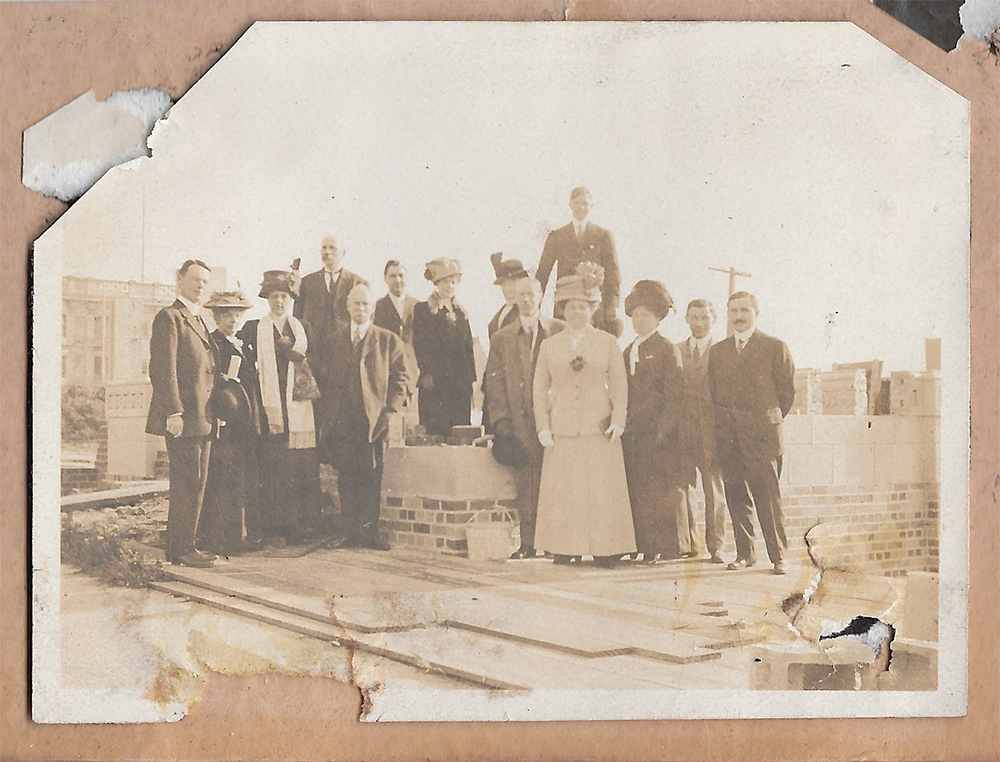
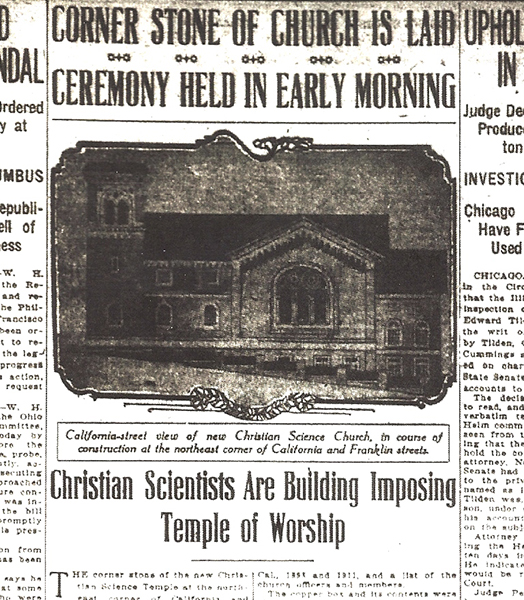
By that year, Christian Science Hall had again filled to capacity, and more members departed to form Fourth Church, holding services downtown. Members of Second, Third and Fourth Churches continued to support what they had begun, however, donating to the building fund of First Church, as did other churches around the Bay Area. In spite of the fact that local business activity was far from fully recovered, each financial obligation for the building was met as it came due. Within two years, construction was completed, and the church was dedicated — debt-free — in 1913.16
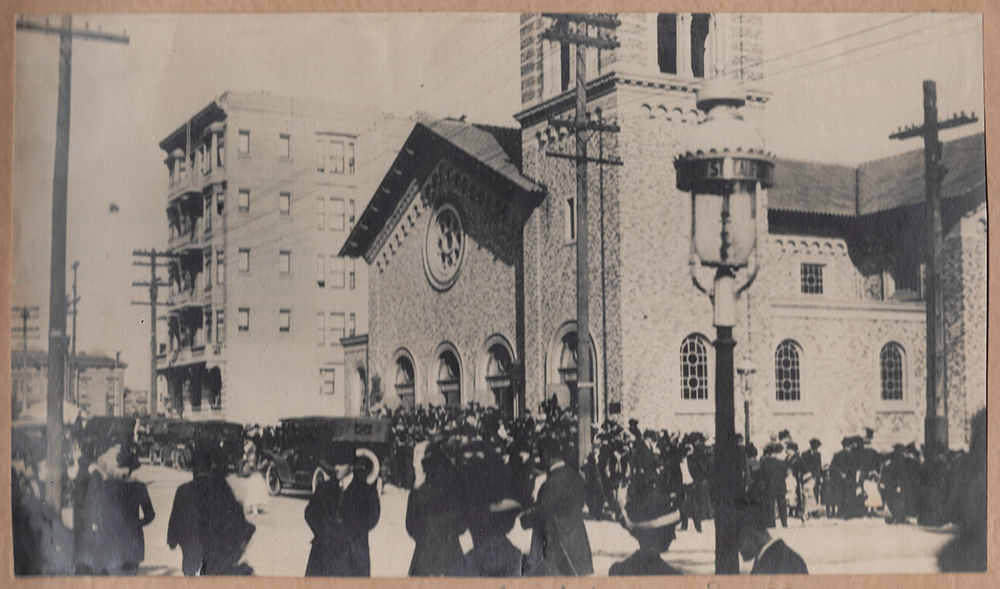
The spreading of Christian Science in the West, which Mary Baker Eddy had hoped for and prayed about — whose standard had been planted by one lone young woman — continued to march forward into the 20th century.
